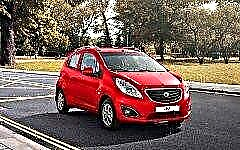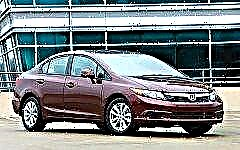 An article about the most interesting facts from the history of the Maybach brand, the formation and development of the company, ups and downs.
An article about the most interesting facts from the history of the Maybach brand, the formation and development of the company, ups and downs.

The content of the article:
- Personalities
- Counterfeit money
- Honeycomb radiator and carburetor
- What Maybach and Mercedes have in common
- Airships
- First Maybach
- Military projects
- Post-war history
- 1997, brand revival
- 8-speed and DS8 Zeppelin
The history of Maybach cars is ambiguous and interesting at the same time. Few people know how extensive this German company has left in history. Consider the most interesting facts from the biography of this legendary brand.
1. Personalities

The founder of the brand is considered to be Wilhelm Maybach, the son of a carpenter, who was orphaned at the age of 10. He grew up in a commune where the vicar who ran it taught the boys engineering. Although the venture was not very successful from a commercial point of view, it revealed a young, gifted designer. So gifted that later even competitors called him "the king of designers."
It was this factor that played a huge role in the formation of the brand, and the talent was inherited by his son Karl Maybach, under whose leadership the company became famous all over the world.
Then fate brought Maybach to Gottlieb Daimler. Arriving at the commune with the aim of reorganizing unprofitable production, he considered the potential of Wilhelm and interested him in the design of internal combustion engines. After training in drawing science and almost 10 years of joint work with Daimler, car designers developed their first high-revving, but very light engine. Thus, two legendary engineers have teamed up to create their own, unique and inimitable brand.
Another personality that cannot be ignored in the context of the Maybach is Graf Zeppelin. By involving experienced engineers in the creation of airships and the development of aircraft engines, they were then able to significantly improve the efficiency of their vehicles.
2. Counterfeit money

Wilhelm Maybach made the first experiments with internal combustion engines together with Gottlieb Daimler back in 1883. Then it was not very clear how and why to use a rather weak motor, and therefore they attached it to the bicycle frame. Thus, their first motorcycle saw the light.
There was a workshop in a former greenhouse, where engineers not only engaged in design, but also made mechanisms useful in everyday life, which allowed them to earn money for new experiments.
For the end of the 19th century, gasoline engines were a novelty - people were afraid of the sharp smell of exhaust gases, reacted negatively to noise, since the first engines did not have mufflers. When budding designers began to start their engines, neighbors mistook them for counterfeiters and even called the police. As a result, Daimler and Maybach had to prove that they were not involved in the production of counterfeit money.
3. Honeycomb radiator and carburetor

Maybach gave the world many innovative design solutions for its time. Among other things, there was a honeycomb radiator, which increased the cooling efficiency of the power unit. Prior to this, engineers used a simple liquid radiator or air cooling. This led to frequent overheating of the motors, which by that time had already become quite powerful.
Then Maybach patented the world's first jet carburetor. This invention gave a huge impetus to the development of car power systems. Further development of technology led to the improvement of jets, and, accordingly, greater efficiency of power units.
The listed inventions are only a small part of the novelties developed by Maybachi's father and son.
4. What do Maybach and Mercedes have in common

Not so long ago, German manufacturers produced the Mercedes-Maybach car. But not all motorists know that this combination has historical roots, and not just bought out by Mercedes.
The fact is that the first racing car to be named "Mercedes" was designed by Wilhelm Maybahom. This is completely his brainchild, which he created by order of Emil Jellinek. This car was produced at Daimler facilities, and in the future, the products of this plant retained the well-known name "Mercedes".
Wilhelm worked in the company until 1907, under his leadership, all Mercedes models that were produced in those years were created, and the developments were used even after he left the company. Therefore, the Mercedes brand is directly related to Maybach, even though Wilhelm and his son Karl went their own way, refusing to cooperate with Daimler.
5. Airships

After leaving the company that gave them the road to the automotive world, the Maybachs unexpectedly did not start a car company. They began to cooperate with Count Zeppelin, who at that time was producing airships.
Here they were able to get a very interesting and responsible work on the study of the features of the use of airships. They had to have very reliable engines capable of operating in difficult weather and technological conditions. At that time, there were practically no motors satisfying such a request.
Airship manufacturers tried to install auto and aircraft engines, but they did not fit in a number of technological nuances.
It was by creating engines for airships that father and son gained world fame. For a very long time, the public inextricably linked them with imposing giant aircraft. Only a dozen years later, the glory of the creator of motors for airships peeled off the Maybachs.
6. The first Maybach

The return to automobile construction came about for a number of reasons. Here are some of them:
- Karl's desire to develop in the creation of motor vehicles;
- economic problems in post-war Germany.
Karl has repeatedly announced that his real passion is building cars, not airships. But during the First World War, they were in great demand, and the Zeppelin company developed rapidly.
Although the count believed that this transport was the future, life showed otherwise. During the war years, airships were primarily remembered as bombers, so after the defeat of Germany, it was forbidden to maintain military airships. Since the market for cargo air transport did not exist then, and difficult economic conditions did not allow it to be born, the company's glory began to fall, and the Maybachs stopped working with Zeppelin.
The airships were finished in 1918, and already in 1919 they presented their first car bearing their name. The first model was the Maybach W1. It was created on the basis of the Daimler chassis and had a 46 hp engine. and six cylinders.
Parallel to this, they created a motor for several executive cars commissioned by one of the Dutch firms. And already on the basis of this engine, the Maybach W2 car was created. Moreover, he was immediately assigned to the class of limousines, which predetermined the development of the brand as a car for rich people.
The reason for this choice is trivial - their main competitor, Daimler-Benz, had capital, assembly lines, and experienced managers. Therefore, the Maybachs could not compete with competitors in the mass segment, but in the premium segment such a problem did not exist.
But the most famous company brought "Maybach W3". It was presented at the Berlin Motor Show and had a number of innovations that were ahead of their time:
- Brakes were first installed on all wheels;
- Each cylinder had 2 spark plugs;
- Instead of a clutch, they installed three pedals that change gears.The first pedal is the main one, the second is used when climbing uphill, the third is reverse.
The next model had the same transmission, but later, with the increase in power, this decision had to be abandoned.
7. Military projects

With the outbreak of World War II, the demand for limousines began to decline. As a result, since 1941, the company has been working only with defense orders, producing engines for heavy military equipment.
During the war years, more than 140 thousand power units of various capacities were produced. Perhaps the most famous are the Maybach HL 230P30, which have a capacity of 700 hp. They were installed on the Tiger and Panther tanks, as their power and high reliability made them massive, well-protected and very dangerous for the enemy.
8. Post-war history

War always has a negative impact on the economy, and the Maybach company felt it very well. After the victory of the allies, she again began to experience financial difficulties. There were no orders for military equipment, and the consumer was not interested in the segment of expensive cars. Europe was ravaged by war, factories damaged by bombing. In addition, Karl had to forcibly work for several years in France as punishment for collaborating with the Nazis.
In 1957, Maybach tried to create a new car that could bring the company back to the market. But he did not succeed. Probably, age affected, because he was almost 80 years old. After his death, the Maybach company passed to the competitors of Daimler-Benz.
9.1997 revival of the brand

At the end of the twentieth century, Daimler-Benz marketers were looking for a way to increase sales of their products in the premium segment, and then the Mercedes-Benz Maybach concept car appeared.
But the idea can hardly be called successful. Consumers perceived the new car as a Mercedes, only with a different nameplate on the body. Therefore, it was not possible to achieve much success, and in 2015 the release of Maybach was once again stopped.
10.8-speed gearbox and DS8 Zeppelin

Now the most popular, the most demanded gearbox is not the classic mechanics, but the 8-speed transmission. It is installed on almost all cars of all manufacturers, from BMW to Bentley.
Maybach was the first to use 8-speed automatic transmissions on its vehicles. This happened already in 1929. This approach made it possible to make the movement of the car as smooth as possible for that time.
The DS8 Zeppelin transmission is also unique. It was installed on models produced in the late twenties. This box was electrically driven. In fact, it was on its basis that the first subsequent automatic transmissions were developed.
The brainchild of Karl Maybach can be called the predecessor of a large number of transmissions, which were designed taking into account his developments. Perhaps this is one of his most significant achievements, albeit undeservedly forgotten.
Although the history of Maybach is quite interesting and multifaceted, the brand's cars for some reason could not find their place in the modern automotive world.











